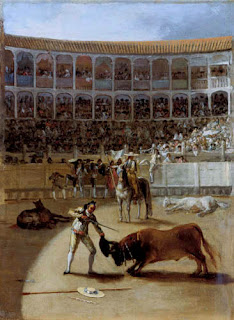In a recent article Minoan ‘Horns of Consecration’ Revisited: A Symbol of Sun Worship in Palatial and Post-Palatial Crete By Emilia Banou we take a closer look at the meaning behind these horns and how such a symbol came to be in Crete. It is suggested that these horns of consecration are not actually representatives of bulls’ horns after all, and they are, in fact of Egyptian descent. The horns have striking similarity to the Egyptian symbol of horizon. This
 |
| The Narmer Palette |
According to MacGillivray the Minoans used three calendars one of which is a solar, a lunar and an astral calendar were all three used to measure time in the Minoans’ civilization. If this were the case, then the horns would be a reference point used to show where the solstices and equinox appeared yearly. There is evidence lying in the symbols on the headdress of the goddess with upraised arms who relates to the god Hathor, and therefore becomes related to the sun. Hathor is the Egyptian goddess of love and beauty, joy and motherhood, one of the most important deities to Egyptians. The image of Hathor is often a cow goddess with head horns that hold a sun disk. It has been speculated that she may be the cow goddess depicted on the Narmer Palette. It has been told that the sun god Horus is “housed” inside of her.
 |
| Hathor shown on the left |
There is a clear visual connection between these two symbols. We see the horns of consecration atop Hathor’s head, and in this depiction there is a direct correlation between the horns and the sun. Egyptian religion has influenced a great many religions, and seeing as how the Minoans and the Egyptians did business together, it is not unlikely that the both of them took from one another many customs and traditions, including deities and symbols alike. I do not wish to deny or confirm speculations of one influencing the other; however I wish to illustrate their involvement with one another.
The Minoans share many beliefs with the Egyptians, as I have stated before, they were most definitely involved, however who influenced who is hard to tell, it is clear that each had a focus, and each took what they wanted from other religions. The theme of the cow goddess is prevalent in Minoan myth, and the Egyptians must have been aware of this. The use of the symbol of the bull horn seems to be a coincidence, however the meaning that each culture gave to this symbol, I believe, held many of the same principles, with focus on separate areas.
This symbol symbolizes the sun to the Egyptians, yet it is indicative of Hathor’s cow descent, which could have been an interpretation of Minoan myth. The horns of consecration, according to Evans, were used for a ritual seat, though this is highly imaginative, it is not preposterous. The location of the horns seem to symbolize sunlight, however, and in certain points on the calendar, the sun, moon, and various astrological symbols may be outlined by the horns themselves, giving reference to the Egyptian goddess Hathor. We cannot forget that the Minoans also considered the sun to be involved in the mythology of the bull; the bull was used to represent the sun, according to recent discovery. This could be argued as well; the horns of consecration represent the bull in conjunction with the sky god, who was represented as a bull, therefore connecting the earth god with the sky, and doing so symbolically.










